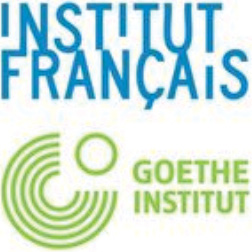The cultural institutions of France and Germany exist together under one roof. What could seem to be a carefully mapped out endeavor happened by sheer coincidence. At the beginning of 2004, the Institut Français and the Goethe-Institut were looking for new and larger office spaces. Nobody knew then that this rather spontaneous decision would turn into a manifest of German-French friendship in the form of a four-story building located in the heart of Ramallah. For 15 years now, both institutions have been working as the French-German Cultural Center (FGCC) on joint projects while benefitting from each other’s areas of expertise and networks. This cooperation between the two former archenemies remains unique worldwide. Being a meeting ground, an art space, and a point of connection between Palestine and Europe, the center particularly attracts a young audience through its rich program in the fields of language, culture, and education.
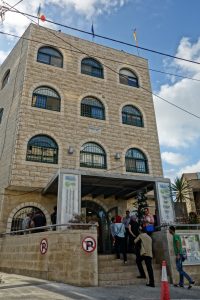
Named after Robert Schuman, the former French foreign minister and one of the founding fathers of what is known today as the European Union, which was in its very essence a peace project after the Second World War, FGCC’s library offers more than 11,000 different kinds of media in French, German, and Arabic. “I enjoy coming to the library for its calm atmosphere,” says Haneen Esnaf from Birzeit. “I am enrolled in a French course at the moment, so I like to browse through French books in order to see what I can already understand.”
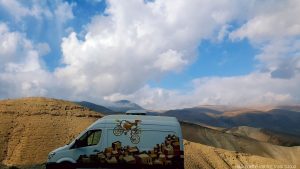
For everyone whose way to Ramallah is either too long or closed by Israeli checkpoints, FGCC offers an alternative on wheels: The “Bibliobus” regularly visits schools in the West Bank, East Jerusalem, and the Gaza Strip to provide children and teenagers with reading material. Yet, on board is not only a wide selection of books and audiovisual materials but also FGCC’s Bibliobus coordinator, Hamza Bakri, who has a number of ice-breakers, language games, and body exercises up his sleeve. “When I take the bus to schools in Jenin, Hebron, or Tulkarem, I leave Ramallah very early in the morning. Getting up has never been easier because I see my work as truly meaningful. The kids are often waiting at their school gates. My goal is to make their learning enjoyable and enriching. I believe that we need safe learning environments where self-expression is welcome.”
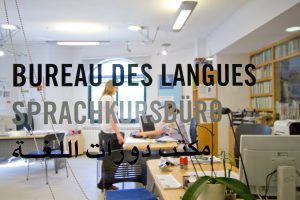
FGCC makes concepts such as freedom of expression, artistic courage, and creativity come alive while highlighting the linkages between France, Germany, and Palestine. Its rich cultural program takes place primarily in its in-house gallery, one of the very few white cubes on site. Michael Jabareen, a graduate of Birzeit University in architecture and engineering, recently presented his art in an exhibition of upcoming Palestinian artists. “When I brought along some of my works to my German class at the center, my teacher noticed them. This is when my connection with FGCC as an artist began to develop,” remembers the 26-year-old from Jenin. “What is special about FGCC is the exposure I get as a young artist. Many people come to the gallery, even those who are not primarily interested in art. This gives me the opportunity to present my work to a much broader audience.”
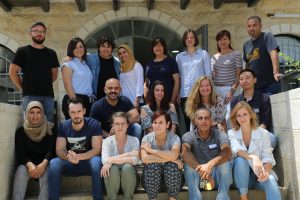
Last year’s “En Chemin” (French for “on the way”), a two-week residency program in Sebastiya curated by Jack Persekian and supported by Raja Shehadeh, brought together artists who reside in Palestine, France, and Germany to focus on the notion of movement. Among them was Dima Srouji, whose contribution explored the human breath as a tool of freedom through the artistic craft of glass blowing. “The residency was one seed out of which many new connections, ideas, and projects have been sprouting ever since,” says Dima who also collaborated with local craftspeople from Jaba. “Meeting artists with similar interests and passion for the region while being introduced to Sebastiya, a place by which I was enamored, was truly eye-opening for me and very influential for my practice today.”
Every other month, FGCC’s backyard turns into a vivid meeting point for language enthusiasts: Sitting areas are set up, drinks and snacks are prepared, and fairy lights create a cozy atmosphere, all of which sets the base for an evening dedicated to languages. In cooperation with BlaBla Language Exchange, FGCC invites everyone who studies a foreign language to converse, learn, and share what they know. “I come to FGCC because in a second, I meet like-minded young people who share my joy in languages,” says Haneen Tafesh who regularly joins the gatherings. “Learning a second language really helps to see the world from a different perspective.”
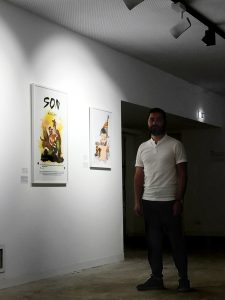
That learning languages opens up doors to whole new worlds is well known to Iyad Fuqaha, too. The 24-year-old from Ramallah, who finished his first German courses at FGCC in 2013, is now about to graduate from a bachelor-degree program in mechatronics at one of Germany’s leading technical universities (TU9), and his study program is entirely in German. “Studying in Europe is a challenge. Frankly, it requires a lot of courage and a clear mindset. The atmosphere at the institute is a reflection of Europe. When I arrived in Germany five years ago, I immediately started to notice some things that were familiar. This helped me a lot at the beginning.” Whenever Iyad returns to Palestine, he pays FGCC a visit: “I like to share my experiences with those interested and to talk about what is possible.”
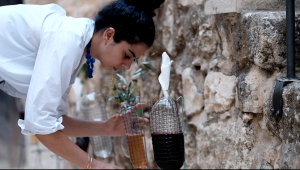
Scaling-up FGCC’s spirit of European community and friendship, France and Germany signed the Treaty of Aachen on January 22, 2019, and agreed to open ten new joint cultural centers by 2020. The success of the French-German cooperation in Ramallah has made it a one-of-a-kind model for serving youth worldwide and achieving greater impact in all areas of cultural action. In Palestine, FGCC could serve as a model for expanding cooperation in the Gaza Strip where joint efforts aim to provide space for open debate, expression, and free thought. In August, the Goethe-Institut will offer the first summer camp for children hosted by the Institut français in Gaza. This initiative paves the way for further Franco-German cooperation all over Palestine.
Guillaume Robert
Director of the French Institute of Jerusalem
Mona Kriegler
Director of the Goethe-Institut Ramallah

